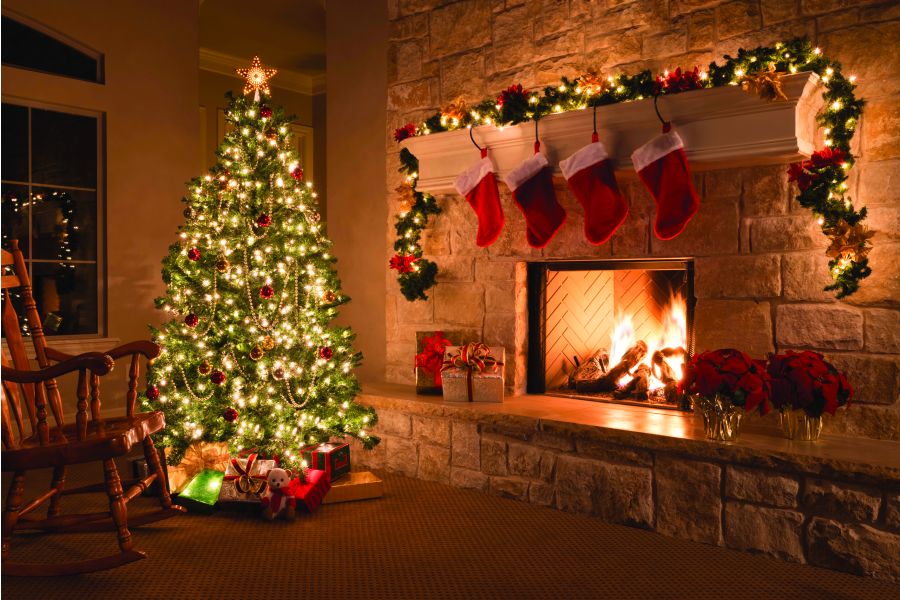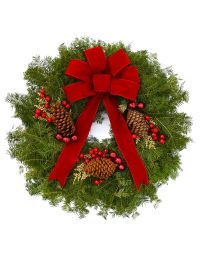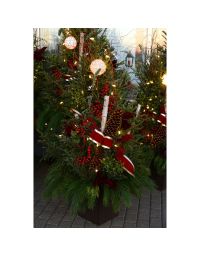Christmas Tree Facts By The Year
- The first decorated Christmas was in Riga, Latvia in 1510.
- The first printed reference to Christmas trees appeared in Germany in 1531.
- Christmas trees have been sold commercially in the United States since about 1850. Until fairly recently, all Christmas trees came from the forest.
- The first Christmas tree retail lot in the United States was started in 1851 in New York by Mark Carr.
- In 1856 Franklin Pierce, the 14th President of the United States, was the first President to place a Christmas tree in the White House.
- Thomas Edison’s assistant, Edward Johnson, came up with the idea of electric lights for Christmas trees in 1882.
- Christmas tree lights were first mass produced in 1890.
- In 1900, large stores started to erect big illuminated Christmas trees.
- President Coolidge started the National Christmas Tree Lighting Ceremony on the White House lawn in 1923.
- Between 1887 and 1933, a fishing schooner called the "Christmas Ship" would tie up at the Clark Street Bridge and sell spruce trees from Michigan to Chicagoans.
- Every year since 1947, the people of Oslo, Norway have given a Christmas tree to the city of Westminster, England. The gift is an expression of good will and gratitude for Britain's help to Norway during World War II. The industry employs over 100,000 people. Many Christmas tree growers grow trees on a part-time basis to supplement farm and non-farm income.2-3 seedlings are planted for every harvested Christmas tree.
- Since 1966, the National Christmas Tree Association has given a Christmas tree to the President and first family.
- In 1963, the National Christmas Tree was not lighted until December 22nd because of a national 30-day period of mourning following the assassination of President Kennedy.
- Since 1971, the Province of Nova Scotia has presented the Boston Christmas Tree to the people of Boston in gratitude for the relief supplies received from the citizens of Boston after a ship exploded in 1917 following a collision in the Halifax, Nova Scotia Harbor. Part of the city was leveled killing and injuring thousands.
- In 1984, the National Christmas was lit on December 13th with temperatures in the 70's, making it one of the warmest tree lightings in history.
- In 1979, the National Christmas Tree was not lighted except for the top ornament. This was done in honor of the American hostages in Iran.
Christmas Tree Farming Facts
- Thirty-four to thirty-six million Christmas trees are produced each year and 95 percent are shipped or sold directly from Christmas tree farms.
- In the United States, there are more than 21,000 Christmas tree growers.
- In the United States, there are more than 12,000 cut-your-own farms.
- Christmas trees are grown in all 50 states including Hawaii and Alaska.
- 98 percent of all Christmas trees are grown on farms.
- More than 1,000,000 acres of land have been planted to Christmas trees.
- More than 2,000 trees are usually planted per acre. On an average 1,000-1,500 of these trees will survive. In the North, maybe, 750 trees will remain. Almost all trees require shearing to attain the Christmas tree shape. At six to seven feet, trees are ready for harvest. It takes six to ten years of fighting heavy rain, wind, hail and drought to get a mature tree.
- California, Oregon, Michigan, Washington, Wisconsin, Pennsylvania and North Carolina are the top Christmas tree producing states.
- Helicopters help to lift harvested Christmas trees from farms.
- Christmas trees take an average of 7-10 years to mature.
Christmas Trees and the Environment
- 93% of real Christmas tree consumers recycle their tree in community recycling programs, their garden or backyard.
- Artificial trees will last for six years in your home, but for centuries in a landfill.
- Christmas trees are baled to protect the branches from damage during shipping.
- An acre of Christmas trees provides for the daily oxygen requirements of 18 people.
- Growing Christmas trees provides a habitat for wildlife.
- Recycled trees have been used to make sand and soil erosion barriers and been placed in ponds for fish shelter.
- Christmas trees remove dust and pollen from the air.
- You should never burn your Christmas tree in the fireplace. It can contribute to creosote buildup.
- Teddy Roosevelt banned the Christmas tree from the White House for environmental reasons.
Miscellaneous Christmas Tree Facts
- The use of evergreen trees to celebrate the winter season occurred before the birth of Christ.
- 100,000 people are employed in the Christmas tree industry.
- A Christmas tree decoration was once banned by the government; tinsel contained lead at one time, now it’s made of plastic.
- Michigan ranks third among all states in the production of real Christmas trees, but grows a larger variety{13}of Christmas trees than any other state.
- Real Christmas trees are involved in less than one-tenth of one percent of residential fires and only when ignited by some external ignition sources.
- The best selling trees are Scotch pine, Douglas fir, Noble fir, Fraser fir, Virginia pine, Balsam fir and white pine.
- Using small candles to light a Christmas tree dates back to the middle of the 17th century.
- Nineteenth century Americans cut their trees in nearby forests.
- In the first week, a tree in your home will consume as much as a quart of water per day.
- More than 330,000 real Christmas trees are sold via e-commerce or catalogs.
- Other types of trees such as cherry and hawthorns were used as Christmas trees in the past.




